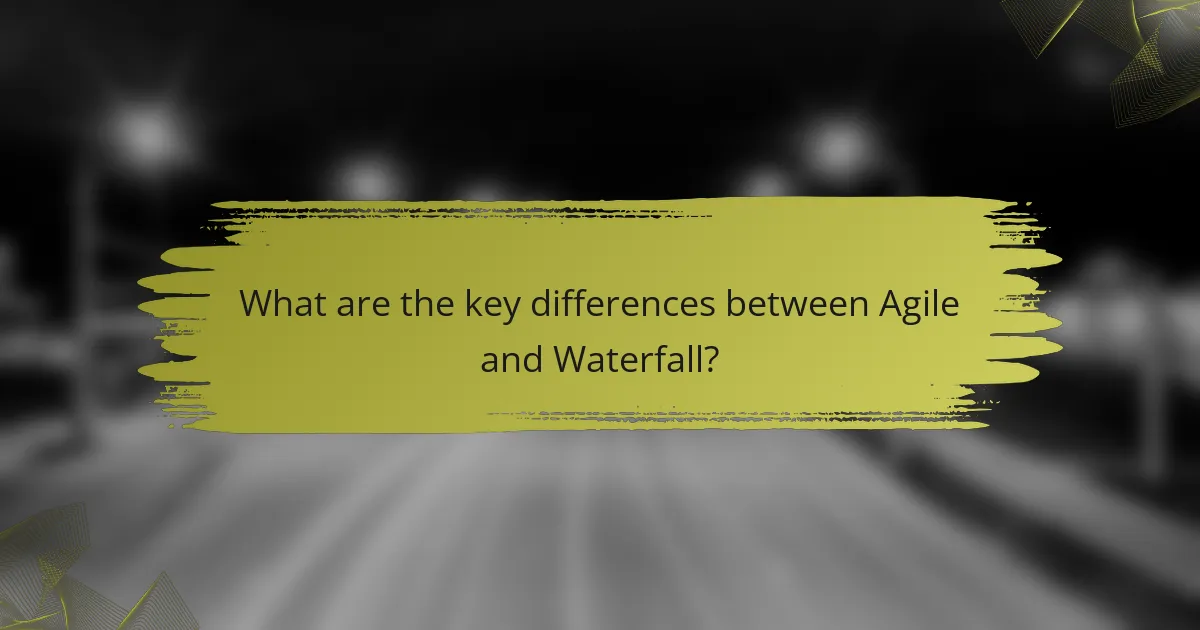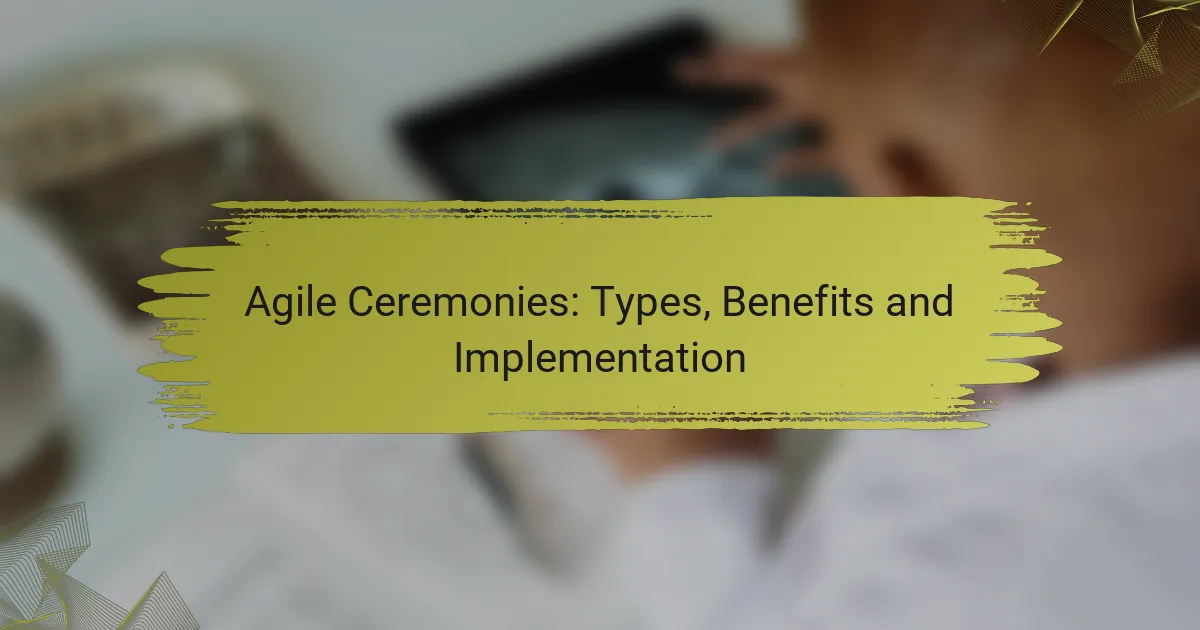Agile and Waterfall are two distinct project management methodologies, each with unique characteristics. Agile is iterative and flexible, making it ideal for projects that require adaptability, while Waterfall follows a sequential and structured approach, best suited for projects with clearly defined scopes and requirements. Understanding the strengths of each methodology can help teams choose the right approach based on their project’s specific needs and potential for change.

What are the key differences between Agile and Waterfall?
Agile and Waterfall are two distinct project management methodologies, each with unique characteristics. Agile is iterative and flexible, while Waterfall follows a sequential and structured approach.
Agile focuses on iterative development
Agile methodology breaks projects into small, manageable units called iterations or sprints, typically lasting a few weeks. This allows teams to deliver functional components incrementally, enabling regular feedback and adjustments based on user needs.
For example, a software development team may release a basic version of an application after the first sprint, then enhance it in subsequent iterations based on user feedback. This iterative approach helps in addressing issues more effectively and improving overall product quality.
Waterfall follows a linear project flow
Waterfall methodology is characterized by a linear progression through distinct phases: requirements, design, implementation, verification, and maintenance. Each phase must be completed before the next one begins, making it a more rigid structure.
This approach is suitable for projects with well-defined requirements and low likelihood of changes, such as construction or manufacturing projects. However, it can lead to challenges if unexpected issues arise, as revisiting earlier phases can be costly and time-consuming.
Agile promotes flexibility and adaptability
Agile encourages teams to be responsive to change, allowing for adjustments in project scope and direction based on ongoing feedback. This flexibility is crucial in dynamic environments where user requirements may evolve.
For instance, if a new technology emerges during a project, Agile teams can pivot quickly to incorporate it, ensuring the final product remains relevant and competitive. However, this adaptability requires strong communication and collaboration among team members.
Waterfall emphasizes detailed upfront planning
Waterfall relies on comprehensive planning at the project’s outset, with a focus on documenting requirements and specifications. This thorough preparation can help in setting clear expectations and timelines.
However, the downside is that if requirements change during the project, it can lead to significant delays and increased costs. Teams using Waterfall must be diligent in their planning and ensure that all stakeholders are aligned before moving forward.

When should I use Agile over Waterfall?
Agile is preferable when projects demand flexibility and rapid iteration, while Waterfall suits projects with a defined scope and requirements. Choosing the right methodology depends on the nature of the project and the likelihood of changes during development.
Use Agile for projects requiring rapid changes
Agile is designed for environments where requirements can evolve quickly. If your project involves frequent feedback loops or needs to adapt to market changes, Agile allows teams to pivot easily and implement changes in short cycles.
For example, software development in tech startups often benefits from Agile methodologies, enabling teams to release updates and new features based on user feedback every few weeks. This adaptability can lead to higher customer satisfaction and better alignment with market demands.
Agile is ideal for projects with unclear requirements
When project requirements are not well-defined, Agile provides a framework to explore and refine them through iterative development. This approach encourages collaboration and continuous improvement, allowing teams to clarify needs as they progress.
In cases like developing a new product where user preferences are uncertain, Agile helps teams experiment with different features and gather insights, ultimately leading to a more user-centered final product.
Waterfall is better for projects with fixed scope
Waterfall is most effective when project requirements are clear and unlikely to change. This methodology follows a linear path, making it easier to manage projects with well-defined stages and deliverables.
For instance, construction projects typically use Waterfall because they require strict adherence to specifications and timelines. Once the requirements are set, changes can be costly and disruptive, making a structured approach essential.
Use Waterfall for regulatory compliance projects
Projects that must adhere to strict regulations often benefit from the Waterfall model. This methodology allows for thorough documentation and a clear audit trail, which is crucial for compliance with industry standards.
For example, in sectors like pharmaceuticals or finance, where regulatory requirements dictate specific processes, Waterfall ensures that all necessary steps are followed systematically, reducing the risk of non-compliance and potential penalties.

What are the benefits of Agile methodology?
Agile methodology offers several advantages, including enhanced flexibility, improved customer engagement, and quicker delivery of products. These benefits make Agile particularly suitable for projects requiring adaptability and ongoing collaboration.
Increased customer satisfaction through collaboration
Agile emphasizes continuous collaboration with customers, which leads to higher satisfaction levels. By involving clients throughout the development process, teams can gather feedback and make adjustments quickly, ensuring the final product aligns closely with customer needs.
This collaborative approach often results in a product that not only meets but exceeds customer expectations, fostering a sense of ownership and partnership. Regular check-ins and reviews help maintain transparency and trust between the development team and stakeholders.
Faster delivery of functional software
Agile methodology promotes iterative development, allowing teams to deliver functional software in shorter cycles, often referred to as sprints. This means that instead of waiting for a complete project to finish, stakeholders can see and use parts of the software much earlier.
For instance, a project that might take several months under traditional methods could yield usable features in just a few weeks with Agile. This rapid delivery not only accelerates time-to-market but also enables teams to respond to changing requirements swiftly.
Improved team communication and morale
Agile fosters a culture of open communication and collaboration within teams, which significantly boosts morale. Daily stand-up meetings and regular retrospectives encourage team members to share updates, challenges, and ideas, leading to a more cohesive work environment.
When team members feel heard and valued, their engagement increases, resulting in higher productivity and creativity. This positive atmosphere can also reduce turnover, as employees are more likely to stay in a supportive and communicative workplace.

What are the limitations of Waterfall methodology?
The Waterfall methodology has several limitations that can hinder project success, particularly in dynamic environments. Its linear approach makes it challenging to adapt to changes once the project is underway, leading to potential issues in meeting user needs and project goals.
Inflexibility to changes during development
One of the primary limitations of the Waterfall methodology is its inflexibility to accommodate changes during the development process. Once a phase is completed, revisiting it can be costly and time-consuming, often requiring significant rework. This rigidity can result in a final product that does not align with current user expectations or market conditions.
For example, if new requirements emerge after the design phase, the team may need to start over, which can lead to delays and increased costs. This lack of adaptability can be particularly detrimental in fast-paced industries where requirements frequently evolve.
Late discovery of issues and defects
Waterfall’s sequential nature often leads to the late discovery of issues and defects, as testing typically occurs only after the development phase is complete. This means that significant problems may not be identified until the final stages, making them more difficult and expensive to fix.
For instance, if a critical flaw is found during testing, it may require going back to earlier phases, disrupting the timeline and increasing the project budget. Early and continuous testing is essential to mitigate this risk, but it is not a standard practice in Waterfall projects.
Higher risk of project failure due to rigid structure
The rigid structure of the Waterfall methodology contributes to a higher risk of project failure, especially in complex projects. If initial requirements are misunderstood or change during development, the project may not meet its objectives, leading to dissatisfaction among stakeholders.
In contrast, more flexible methodologies like Agile allow for iterative development and ongoing feedback, which can significantly reduce the risk of failure. Organizations should weigh the potential for project success against the limitations of Waterfall, particularly when dealing with uncertain or rapidly changing requirements.

How do Agile and Waterfall impact project management?
Agile and Waterfall are two distinct methodologies that significantly influence project management approaches. Agile emphasizes flexibility and iterative progress, while Waterfall follows a linear, structured process.
Agile requires adaptive project management techniques
Agile project management techniques focus on adaptability and responsiveness to change. Teams work in short cycles, known as sprints, allowing for frequent reassessment of project goals and deliverables. This iterative process helps in accommodating evolving requirements and stakeholder feedback.
Common practices in Agile include daily stand-ups, sprint reviews, and retrospectives. These practices foster communication and collaboration, ensuring that all team members are aligned and can quickly address any issues that arise. Agile is particularly effective in environments where requirements are likely to change, such as software development.
Waterfall relies on traditional project management practices
Waterfall project management is characterized by its sequential approach, where each phase must be completed before moving on to the next. This methodology is often used in industries like construction and manufacturing, where requirements are well-defined and unlikely to change during the project lifecycle.
Key practices in Waterfall include detailed documentation, upfront planning, and milestone reviews. This structure can lead to clear timelines and budgets, but it may struggle with flexibility if unexpected changes occur. Teams should ensure thorough initial requirements gathering to minimize risks associated with scope changes later in the project.

What criteria should I consider when choosing between Agile and Waterfall?
When choosing between Agile and Waterfall, consider project requirements, team dynamics, and stakeholder involvement. Agile is best for projects needing flexibility and frequent updates, while Waterfall suits projects with well-defined stages and requirements.
Project Requirements
Assess whether your project has clear, stable requirements or if they are likely to evolve. Waterfall works well for projects with fixed specifications, such as construction or manufacturing, where changes can be costly. In contrast, Agile is ideal for software development or innovative projects where requirements may change based on user feedback.
Team Dynamics
Evaluate your team’s experience and collaboration style. Agile requires a collaborative environment and frequent communication, making it suitable for teams comfortable with iterative processes. Waterfall, however, can be effective for teams that prefer structured roles and a linear approach, allowing for clear accountability.
Stakeholder Involvement
Consider how involved stakeholders will be throughout the project. Agile encourages continuous stakeholder engagement and feedback, which can enhance product relevance. Waterfall typically involves stakeholders primarily at the beginning and end, making it less adaptable to changes in stakeholder needs during the project lifecycle.



